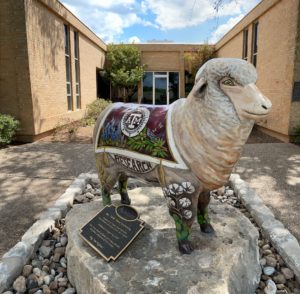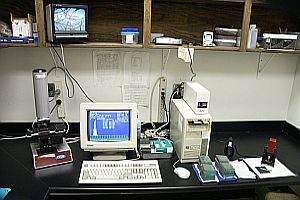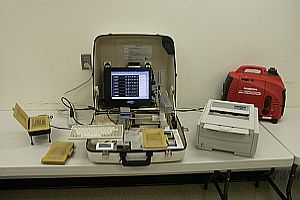For information on test descriptions and submission forms, click here

This statue of the sheep known as TAM “Ewe” niversity stands outside the Texas A&M AgriLife Research and Extension Center of San Angelo
The Wool and Mohair Research Laboratory, Texas A&M University Agricultural Research and Extension Center (now Texas AgriLife Research), San Angelo was established in 1985 to address specific priority needs in the national sheep and goat, wool and mohair research programs. This facility was made possible by $644,000 in funding from USDA and the Texas Agricultural Experiment Station, the Texas A&M University System, plus an additional $150,000 from the Texas sheep and goat industry. The laboratory is a custom designed 4,750 ft building that houses state of the art instruments for the objective measurement of animal fibers.
The San Angelo location was chosen for the new facility because it was already the site of strong production, management and health related research programs funded at an annual level of approximately one million dollars and which are directed primarily at sheep and goat research. The unit is located in an area that supports approximately 20% of the U.S. sheep population and 90% of the Angora goats in the nation. The primary goal of scientists at the Wool and Mohair Research Laboratory facility is to conduct research projects that have high priority to sheep and goat raisers throughout the country. This goal has been achieved by cooperation and support with federal and other state research agencies.
Over the history of this facility the U.S. has gone from being a net importer of wool to a net exporter of wool. Research at the lab in objective measurement of fiber has been critical for insuring that wool imports met specifications of textile mills to currently adding value to exports by insuring that exported wool meets global standards.
Research conducted at the lab during the past 25 years has contributed to:
► Universal acceptance of laser and automatic image analysis technologies for measuring important wool quality traits that are now used by production, marketing, and processing sectors of the animal fiber industry.
► Widespread use by U.S. wool producers of skirting and classing as value-adding practices prior to sale of raw material.
 ► The success of the annual ram and Angora billie central performance tests that assist breeders to identify their superior animals.
► The success of the annual ram and Angora billie central performance tests that assist breeders to identify their superior animals.
► Increased use of pre-sale objective measurements for raw wool and mohair transactions that has resulted in value-based marketing systems that are producing more equitable prices for producers.
► Evaluation in collaborative studies of several new breeds and crossbreeds of sheep that were conducted in western Texas and natio nally.
nally.
► Current knowledge on the effects of North American environments on fiber production by sheep, Angora goats, cashmere goats, and alpacas.
► Successful selection of goats for increased juniper consumption.
► Overall improvement in fiber quality of U.S.-produced wool, mohair, cashmere and alpaca by providing individual breeders with the data they require to make important selection decisions.
► The education and mentoring of undergraduate and graduate students from Texas A&M University, Angelo State University, and universities across the US and abroad.
- Vamshidhar Appareddygudam
Laboratory Coordinator I - Ethan Pope
Wool Lab Technician - Quaid Alvar
Wool Lab Technician
woollab@ag.tamu.edu
(325) 657-7348

